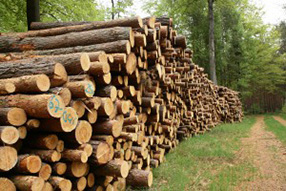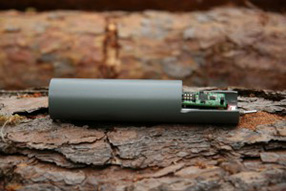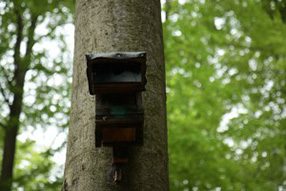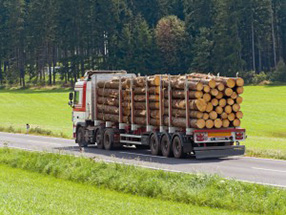Timber theft has been taking the spotlight in recent news with almost no
definitive solution for the crime. The illegal logging industry is increasing,
leaving victims with billions of dollars worth of missing timber worldwide. It
is also the leading cause of deforestation, affecting the eco systems and
natural habitats of endangered species in many countries across the globe.
Spraying the logs, taking records of stocks, immediately applying timber dye to
logs, building relationships with the mill – these are only preemptive measures
a forester can take to ward off thieves and will not stop professionals from
stealing lumber nor will it put them behind bars. Suggested theft prevention
measures until now, unfortunately, have proven to be ineffective in actually
catching the thieves in action.

Those days are now over.
One logging company with an ongoing timber theft problem sought for an
effective theft prevention solution when surveillance efforts failed to stop
further theft. They came to ENAiKOON seeking a GPS tracking solution. After
just three months, our team of dedicated hardware developers created the new
locate-18 GPS tracking device. With its plastic, tube-like housing
that fits discreetly into logs, the locate-18’s sole purpose is to stop timber
thieves in action.

The GPS device alone cannot stop timber theft. ENAiKOON’s complete solution
includes an adjustable vibration sensor, a camera, infrared lights, a GPS
receiver for localisation, a SIM card for GPRS transmission, a powerful set of
batteries, and the use of telematics management software:
inViu
pro.
Here’s how to stop timber theft. First, drill a hole into a log in a felled
lumber pile and insert the 20 x 3.5 cm locate-18 with its vibration sensor
activated. Make the drill holes invisible by covering them up with previously
sawed wooden discs. Then, install cameras with infrared lights in various
loading areas. When the tracked log is moved unexpectedly, the GPS tracking
device sends an alert to the server and activates the surveillance cameras.

This is exactly what the logging company did and just as we suspected,
unusual movement of lumber piles were detected just a month after installation.
They mounted a locate-18 in every lumber pile and hid security cameras in owl
boxes that were hung near their loading areas. When the logs were moved it
triggered the cameras which took photos of the theft at the crime scene; this
evidence was later used in court to support the case. Knowing the exact GPS
coordinates of the moving lumber pile, the logging company found out the logs
were taken to the exact same sawmill that the usual shipments went to,
concluding that it was an insider job. Turns out, the contracted truck drivers
were taking extra loads to the mill. All stolen timber was recovered with the
suspects successfully convicted in court. The company has not seen any criminal
activity since then.
Let’s put an end to illegal logging and timber theft. If you manage a
logging company experiencing timber theft, ENAiKOON’s timber theft prevention
is your solution.
Contact us for a customised solution for your company.
 Those days are now over.
One logging company with an ongoing timber theft problem sought for an
effective theft prevention solution when surveillance efforts failed to stop
further theft. They came to ENAiKOON seeking a GPS tracking solution. After
just three months, our team of dedicated hardware developers created the new
locate-18 GPS tracking device. With its plastic, tube-like housing
that fits discreetly into logs, the locate-18’s sole purpose is to stop timber
thieves in action.
Those days are now over.
One logging company with an ongoing timber theft problem sought for an
effective theft prevention solution when surveillance efforts failed to stop
further theft. They came to ENAiKOON seeking a GPS tracking solution. After
just three months, our team of dedicated hardware developers created the new
locate-18 GPS tracking device. With its plastic, tube-like housing
that fits discreetly into logs, the locate-18’s sole purpose is to stop timber
thieves in action.
 The GPS device alone cannot stop timber theft. ENAiKOON’s complete solution
includes an adjustable vibration sensor, a camera, infrared lights, a GPS
receiver for localisation, a SIM card for GPRS transmission, a powerful set of
batteries, and the use of telematics management software: inViu
pro.
Here’s how to stop timber theft. First, drill a hole into a log in a felled
lumber pile and insert the 20 x 3.5 cm locate-18 with its vibration sensor
activated. Make the drill holes invisible by covering them up with previously
sawed wooden discs. Then, install cameras with infrared lights in various
loading areas. When the tracked log is moved unexpectedly, the GPS tracking
device sends an alert to the server and activates the surveillance cameras.
The GPS device alone cannot stop timber theft. ENAiKOON’s complete solution
includes an adjustable vibration sensor, a camera, infrared lights, a GPS
receiver for localisation, a SIM card for GPRS transmission, a powerful set of
batteries, and the use of telematics management software: inViu
pro.
Here’s how to stop timber theft. First, drill a hole into a log in a felled
lumber pile and insert the 20 x 3.5 cm locate-18 with its vibration sensor
activated. Make the drill holes invisible by covering them up with previously
sawed wooden discs. Then, install cameras with infrared lights in various
loading areas. When the tracked log is moved unexpectedly, the GPS tracking
device sends an alert to the server and activates the surveillance cameras.
 This is exactly what the logging company did and just as we suspected,
unusual movement of lumber piles were detected just a month after installation.
They mounted a locate-18 in every lumber pile and hid security cameras in owl
boxes that were hung near their loading areas. When the logs were moved it
triggered the cameras which took photos of the theft at the crime scene; this
evidence was later used in court to support the case. Knowing the exact GPS
coordinates of the moving lumber pile, the logging company found out the logs
were taken to the exact same sawmill that the usual shipments went to,
concluding that it was an insider job. Turns out, the contracted truck drivers
were taking extra loads to the mill. All stolen timber was recovered with the
suspects successfully convicted in court. The company has not seen any criminal
activity since then.
Let’s put an end to illegal logging and timber theft. If you manage a
logging company experiencing timber theft, ENAiKOON’s timber theft prevention
is your solution. Contact us for a customised solution for your company.
This is exactly what the logging company did and just as we suspected,
unusual movement of lumber piles were detected just a month after installation.
They mounted a locate-18 in every lumber pile and hid security cameras in owl
boxes that were hung near their loading areas. When the logs were moved it
triggered the cameras which took photos of the theft at the crime scene; this
evidence was later used in court to support the case. Knowing the exact GPS
coordinates of the moving lumber pile, the logging company found out the logs
were taken to the exact same sawmill that the usual shipments went to,
concluding that it was an insider job. Turns out, the contracted truck drivers
were taking extra loads to the mill. All stolen timber was recovered with the
suspects successfully convicted in court. The company has not seen any criminal
activity since then.
Let’s put an end to illegal logging and timber theft. If you manage a
logging company experiencing timber theft, ENAiKOON’s timber theft prevention
is your solution. Contact us for a customised solution for your company. 
